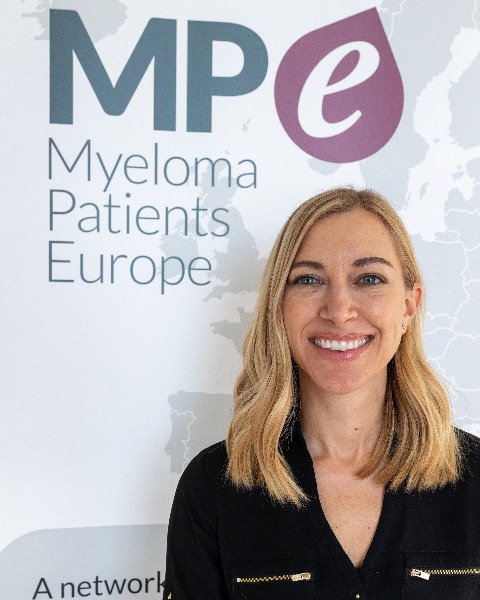Imaging, QoL and Patient-Reported Outcome and Supportive Care
How do patients feel about how, when and where they get their treatments? A European survey of myeloma patients
P-117: How do patients feel about how, when and where they get their treatments? A European survey of myeloma patients
Thursday, September 26, 2024

Katie Joyner
Co-CEO
Myeloma Patients Europe
Munich, Bayern, Germany
Introduction: Myeloma patients may undergo many different types of treatment over the course of their cancer. There is already a high burden on patients due to the myeloma diagnosis, complications, and side-effects of treatments. We need evidence about how people feel, and what they prefer, about how treatments are administered (i.e. intravenous, subcutaneous, or oral routes of administration) and where (i.e. at home, in the community, or in a hospital). This survey aimed to explore perspectives of myeloma patients across Europe.
Methods: Data was collected through an online survey disseminated by myeloma patient organisations in the Netherlands, Germany, Norway, Poland, Portugal, Ireland, France, and Israel and through a European network of myeloma patient organisations. The survey was available in 8 languages. Dissemination of the survey links occurred through social media, patient organisation distribution lists, newsletters, emails, flyers and face-to-face at support groups. Patients’ attitudes to different treatment types were captured on a scale of 1 (entirely negative) to 10 (entirely positive). Perceived burden of treatments was assessed on a scale of 0 (no burden) to 10 (considerable burden) with items related to frequency, effort, physical, daily life, family life, and financial burden.
Results: We received responses from 901 patients from 22 countries. Almost half (47%) of respondents had received 1 line of therapy, 26% had received 2 lines, 11% had 3, and 13% had 4 or more lines. Patients held the most positive attitudes towards oral treatments taken at home (mean 8.2, standard deviation 2.2). Patients were more positive about subcutaneous treatment as an out-patient (mean 7.0) than subcutaneous treatments at home whether delivered by a family member or friend (mean 5.8), by themselves (mean 6.0) or by health professionals (mean 6.8). Intravenous treatment had the highest reported overall burden (mean 30.1) and oral had the least (mean 18.7). The most burdensome aspect of intravenous treatment was reported to be the impact it had on daily activity and daily life. Patients reported the most important features of myeloma treatment to be the physical impact and the impact on day-to-day activities.
Conclusions: This research provides insights into myeloma patients’ attitudes towards, and the differential burden experienced from, different treatment modalities. Contrary to what might be expected, home was not always the most positively regarded location for treatment. The likely physical impact of treatment and the potential impact on daily life should be discussed up-front with patients during treatment decision-making.
Methods: Data was collected through an online survey disseminated by myeloma patient organisations in the Netherlands, Germany, Norway, Poland, Portugal, Ireland, France, and Israel and through a European network of myeloma patient organisations. The survey was available in 8 languages. Dissemination of the survey links occurred through social media, patient organisation distribution lists, newsletters, emails, flyers and face-to-face at support groups. Patients’ attitudes to different treatment types were captured on a scale of 1 (entirely negative) to 10 (entirely positive). Perceived burden of treatments was assessed on a scale of 0 (no burden) to 10 (considerable burden) with items related to frequency, effort, physical, daily life, family life, and financial burden.
Results: We received responses from 901 patients from 22 countries. Almost half (47%) of respondents had received 1 line of therapy, 26% had received 2 lines, 11% had 3, and 13% had 4 or more lines. Patients held the most positive attitudes towards oral treatments taken at home (mean 8.2, standard deviation 2.2). Patients were more positive about subcutaneous treatment as an out-patient (mean 7.0) than subcutaneous treatments at home whether delivered by a family member or friend (mean 5.8), by themselves (mean 6.0) or by health professionals (mean 6.8). Intravenous treatment had the highest reported overall burden (mean 30.1) and oral had the least (mean 18.7). The most burdensome aspect of intravenous treatment was reported to be the impact it had on daily activity and daily life. Patients reported the most important features of myeloma treatment to be the physical impact and the impact on day-to-day activities.
Conclusions: This research provides insights into myeloma patients’ attitudes towards, and the differential burden experienced from, different treatment modalities. Contrary to what might be expected, home was not always the most positively regarded location for treatment. The likely physical impact of treatment and the potential impact on daily life should be discussed up-front with patients during treatment decision-making.